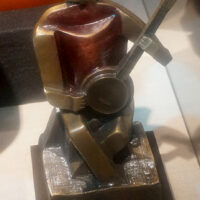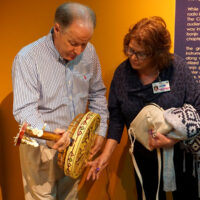
From the hills of North Carolina, came one of the most popular names in the history of the banjo. Earl Scruggs (1924-2012) put his mark on the instrument at an early age. By the time he was 21, Scruggs had become a household name in the world of bluegrass, as he became a member of Bill Monroe & the Blue Grass Boys. Despite incredible success in recording Blue Moon of Kentucky, and after a performance on the Grand Ole Opry, in 1946 Scruggs resigned as a Blue Grass boy and began a trek down the bluegrass highway on his own.
It wasn’t long after Scruggs’ leaving Monroe that another band member, Lester Flatt, also left the band. In 1949, the duo formed Flatt & Scruggs and The Foggy Mountain Boys. Also, in the year 1949, Scruggs recorded perhaps the most iconic banjo tune ever, his own Foggy Mountain Breakdown, which defined a style that is still played to this day. Then in the 1960s the pair became widely known on television for their roles on The Beverly Hillbillies.
Earl has been recognized for his ownership of many banjos, and for many produced with his name by Gibson. The latest, a gold and silver plated, engraved and hand painted Mastertone, The Earl, was introduced in 2002. Of all the banjos that Scruggs has held in his collection, there are a few that are notably more famous than others: his first banjo, the 1934 Gibson RB-11, his primary performance banjo, a 1930 Gibson Granada (which was also his recording instrument from 1949 until his death in 2012), and a one-of-a-kind custom Deluxe Vega banjo.
The Earl Scruggs Deluxe five-string banjo made specifically by Vega in 1960 bore a resemblance to Vega’s ultra-fancy tenor and plectrum banjos, according to Johnny Baier of The American Banjo Museum. The Scruggs Vega displayed engraved and gold-plated parts, engraved mother-of pearl position markers on the fingerboard, a straight grain maple neck, and, probably the most notable, a thin sidewall resonator elaborately decorated in the manner of the Vega company’s idolized Vox IV model.
Scruggs’ personality showed in the production series as his cam D tuners were in the center of the peghead. Vega could not brand this Scruggs instrument in its typical location, however, so they used a metal plate near the top of peghead to showcase their name. It wasn’t long after Earl was presented his own unique Vega, that Vega rolled out the Earl Scruggs Model. Of course the association with Scruggs made this series become a bestseller in the production line. During this period, he became an endorser for the Vega, and could be seen performing with his Vega banjo.
Although the Vega company touted that Earl Scruggs’ Vega was “made to specifications of Earl Scruggs,” from the public’s eye, one may have thought that the Vega was Scruggs’ favorite banjo. But, for the real banjo enthusiast, there is an entirely different story which has come to light in recent years. The Earl Scruggs model simply didn’t live up to what Earl wanted as a musician and artist. As a direct result, Scruggs would pick up his old stand by Gibson Granada for the majority of his live radio and recording performances. However without fail, Scruggs dutifully utilized his Vega for promotions and certain appearances. Although often put away tightly in it’s case, the Vega was always on tour as it rode on the tour bus, purposely with a broken head. When fans and the media would ask about the Vega, Earl would pull out his case, open it and say, “The head broke, so I had to play my Gibson tonight.”
Many have questioned just what happened to Scruggs’ iconic banjos. Earl held tight to his Granada until his death in 2012, and today that instrument can be seen at the Country Music Hall of Fame in Nashville. There were rumors of sightings of his Gibson RB-11, but what happened to that specific banjo is still a mystery. Also, for many years no one really knew where the Scruggs Vega was. Then came the big announcement earlier this year that Earl Scruggs musical instruments would be offered for sale. The buzz between the banjo enthusiast and bluegrass community was incredible the days prior to the gavel hitting the auction block. One of the cases that was opened that day had been the tomb of the Vega. Resurrected, and on display in living color for the first time, the Vega now has a new home. You too can see the Scruggs Vega Banjo in Oklahoma City, at the American Banjo Museum.










